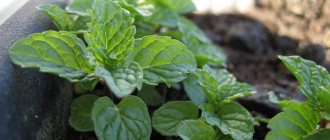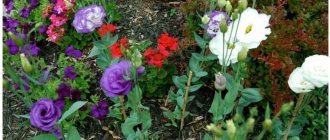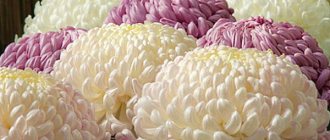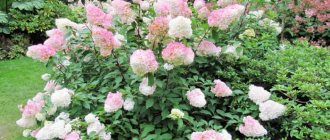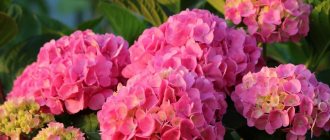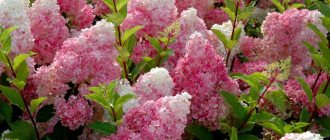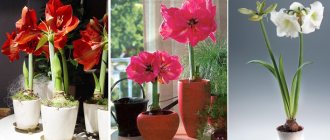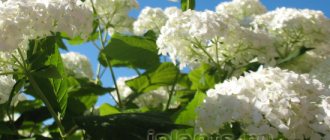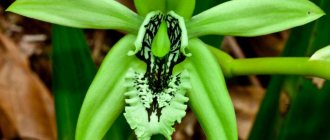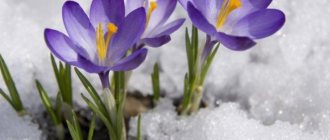Hydrangea Anabelle is the most common variety of tree hydrangea. This shrub will decorate any garden. During flowering, the plant looks very impressive and attracts attention. It is unpretentious in care, thanks to which it is successfully grown in different regions of our country. Even a novice amateur gardener can grow this beauty. In the article we will give recommendations for planting and caring for Anabelle hydrangea in open ground. Also in the publication you will find a photo and description of Anabelle hydrangea.
Description of the flower 2. Subtleties of planting 2.1. Selecting a location 2.2. Soil preparation 2.3. Planting dates 2.4. How to plant a plant 3. Caring for Anabel hydrangea 4. Flower propagation 4.1. Reproduction by division 4.2. Reproduction by layering 4.3. Propagation by cuttings 5. Diseases and pests 6. Plants in landscape design
Photo: Plants of this variety are unpretentious in care and will decorate any area with spreading white flowers.
Landing Features
The success of growing hydrangea depends on compliance with the timing, planting rules and further care.
Disembarkation times vary depending on the region:
- in the south, in the Middle and Central zone - spring and early autumn;
- in areas with harsh climatic conditions - mid-spring (so that the bushes have time to take root and prepare for winter during the season).
Organization of the place
The plant prefers to grow in sunny places where there is good light in the morning and evening. When planting in the southern corner of the garden, it needs shading, because the leaves and flowers fade quickly.
You should not plant under the walls of a house, tall and spreading trees, where there is constant shade. At this point, the hydrangea stops growing, the leaves become pale, and the flowering is poor.
The soil is light, loose and highly acidic. When planted on alkaline soil, the foliage turns yellow; on calcareous soil, growth is retarded and the flowers do not bloom so abundantly and colorfully.
Preparation of planting material
You can purchase Pink Annabelle hydrangea in one of the specialized stores or nurseries.
The best material is considered to be seedlings 2-3 years old with closed roots (in an earthen coma or container). Such plants have a well-developed root system and crown. In addition, they take root faster and better after transplantation to the site.
When purchasing, carefully inspect the shoots and foliage - they should not be yellow, black spots, growths or mechanical injuries. If the leaves do not fall off when shaking, it means the plant is fresh.
The substrate is slightly moist, without mold or acidification on the surface.
Before planting, the root system needs to be trimmed a little to stimulate the development of new roots.
Landing technology
The planting site is prepared two weeks before the planned planting of seedlings - all garden debris and plant debris are removed, dug up, and leveled.
Dig holes slightly larger than the size of the root system. Approximate dimensions are 55x50 cm. Drainage (pebbles, crushed stone or screenings) is placed at the bottom to ensure good drainage of moisture from the roots. A nutritious composition of peat, leaf soil, humus and sand, mixed in equal quantities, is sprinkled on top.
The roots are lowered, straightened, covered with the remaining soil mixture, compacted, and watered. Consumption per bush is 10 liters of water. To prevent the soil from drying out, the tree trunk area is mulched with peat or humus.
When growing in groups, you should adhere to the 3x2 m pattern. This way, the plants will fully develop and there will be no competition for moisture and nutrients.
In the first two weeks, seedlings are very sensitive to sunlight and can quickly burn out. Therefore, during lunch hours they are shaded with agrofibre or burlap.
Application in landscape design
Hydrangea is suitable for creating different compositions in the garden:
- the bush is planted singly in the center or along the edges of the garden, where it is necessary to create bright colorful landscaping;
- planted in groups in combination with varieties of tree hydrangeas of other colors;
- The shrub looks great surrounded by perennials - roses, junipers, dwarf fir;
- grown near gazebos and terraces;
- used in creating multi-level flowering compositions, planted in the background.
This unique plant has won the hearts of many gardeners, therefore it is in great demand and has a positive characteristic:
- has good frost resistance and winter hardiness, which allows it to be successfully grown in different climatic conditions;
- with good care, it blooms for a long time, luxuriantly, and is practically not damaged by diseases and pests;
- It perfectly tolerates the proximity of other vegetation and decorates any area in the garden.
The post Hydrangea arborescens Pink Annabelle - how to care for the plant appeared first on Farmoved - Livestock and Garden.
Which one is better to plant in the Urals?
In the Urals, you can plant all of the above types of hydrangea. Each of them shows the ability to survive in low temperatures. But tree-like and paniculate varieties are characterized by maximum frost resistance. Most varieties of these hydrangeas are able to tolerate temperatures down to -40°C, which should be the determining factor when choosing a crop for cultivation in the conditions of the Urals.
It is best to purchase planting material obtained in the area where they plan to plant it, rather than importing it from other regions.
Important! Hydrangea is a natural indicator of soil acidity and alkalinity. The color of its inflorescences changes depending on the level of these indicators: high acidity - blue flowers, neutral soil - white, high alkalinity - lilac-pink
Transfer
When is a transplant needed? Some gardeners' hydrangeas stopped blooming because trees growing nearby created too deep a shadow. In other cases, mature bushes may outgrow the available space.
The best time to replant is when the plants are dormant and there are no leaves on the plant.
In southern regions and zones with warm winters, replant from late autumn to early winter, if the ground does not freeze, replant from late December to February.
After transplanting, abundant watering is required. You may need to water during the winter if the soil is dry. When warm weather arrives, plan to water during the first and second summer.
Tree hydrangea: varieties with photos
The most popular varieties:
- Annabelle tree hydrangea;
- Hydrangea tree grandiflora;
- tree hydrangea bounty;
- Hydrangea tree sterilis;
- Hydrangea tree incredibol.
We will analyze each type separately and provide a brief description.
Annabelle
This hydrangea has spherical inflorescences with white flowers. The diameter of the inflorescence is up to 20 centimeters. The height of the bush is no more than one and a half meters, but it spreads out to the sides quite strongly, the volume can reach three meters.
The plant blooms from June to September. At the same time, due to the heaviness of the inflorescences, the bush bends the branches towards the ground. Therefore, it is better to tie up the tree to avoid breaking the branches. The Annabelle variety is unusual in that its foliage remains green until frost.
Popular articles Description and cultivation of large-leaved hydrangea Miss Saori
Grandiflora
This is an artificially bred variety, which was obtained by selecting the tree hydrangea variety “Anabelle”. A special feature of this variety is its large cream or lemon-colored inflorescences. The Grandiflora bush can reach a height of two meters. It blooms from June to September.
The height of the bush can reach from one and a half to three meters. But the branches of the bush are fragile and bend towards the ground when flowering.
Sterilis
A plant with very viable cuttings, fast growth and a long period of abundant flowering, which lasts from July to October. Sterilis is similar to Incrediball by changing the color of the inflorescences. With this variety, everything happens the same way - white petals are replaced by greenish ones. The height of such a bush can reach two meters in height, and in volume it can spread over 2.5 meters.
Bounty
This hydrangea is often used for decorative purposes as a hedge, since the height of the bush does not exceed one meter. Bounty's inflorescences are cap-shaped and are about 30 centimeters in diameter. Color varies from cream to pure white.
Flowering occurs from June to September. These bushes do not require fixing or gartering, as they are quite strong and can withstand any rain and wind.
The range of species is so diverse that any gardener is sure to find a plant to his liking. However, in order for the plant to meet the description, it must be cared for according to certain rules, maintain soil parameters and prune the bush.
Pink Annabelle
The leaves are green, but by autumn they change their color to more yellow. Pink Annabelle blooms from June to September. The inflorescences are quite large and reach 30 centimeters; they resemble a ball in shape. The color at the beginning of flowering is dark pink, and over time it turns into a rich pink. Hydrangea branches are strong and can withstand inclement weather.
To form large and abundant inflorescences, the plant needs pruning. The more you trim the bush, the larger the inflorescences will be, but their number will decrease. This variety is frost-resistant, but in the northern regions it is still worth using shelters.
Pink Annabelle is often used in the design of flower beds. The plant looks great both alone and in an ensemble with lilies and roses.
Strong Annabelle
The bush is usually up to one and a half meters high and 1 meter in volume. The bush itself looks like a ball, its leaves are green, but by autumn they turn yellow. This hydrangea is quite strong and tolerates wind and rain well.
The bush must be trimmed. In severe frosts, the branches may be damaged, but in the spring the plant will recover. Strong Annabelle loves the sun and active watering.
Looks great in a flowerbed as an independent plant or in an ensemble with other flowers. It is also used as a border plant.
Planting and care
Selecting a location
Hydrangea will really like a very bright place, without drafts and direct sunlight. In the shade it will grow and develop a little slower.
Priming
Grows well in any soil, but prefers loamy and acidic soil, as well as good drainage. It is recommended to add a little peat under the bush. The plant does not tolerate calcareous soil and loves humus. Once every six months it is recommended to loosen the soil around the bush. And it is advisable, if possible, to weed the soil from weeds.
The hole for planting is made wide, up to half a meter, since hydrangea has a highly expanding superficial root system. When planting, it is recommended to place 40-60 grams of any mineral fertilizer in the hole, and place the hydrangea itself in a root growth stimulator for a couple of hours.
Top dressing
Fertilizers for hydrangea are suitable both mineral and organic for flowering plants. Apply in spring and summer. Also, if the soil is poor, you can add leaf soil, humus, peat and sand.
Important: lime and ash should not be added to the soil for this shrub!
Reproduction
The plant is propagated quite simply, mainly by cuttings and dividing the bush, sometimes by cuttings.
Cuttings are taken from this year's branches, cut and rooted in soil made of humus, black soil with the addition of sand and peat. It is advisable to plant the cuttings in the shade and cover them with a cut plastic bottle.
The division of the bush during transplantation occurs as follows.
An adult hydrangea is divided into several parts with a shovel, then the roots are separated, being careful not to damage them. Then the resulting shrubs are planted in the ground and watered abundantly.
Popular articles Growing large-leaved hydrangea Alpenglüchen
Trimming
Plants of this species respond well to pruning. It is carried out to form a lush, rounded crown.
Pruning is carried out mainly in the fall. Remove faded flowers and old dry shoots. This will give the plant strength to grow new shoots.
In March - April, the bush is subject to a rejuvenation procedure. Select about 10 young shoots and cut them by 1/3. The remaining shoots need to be sawed off.
It is recommended to prune as the flower grows.
Important: plants under 3 years of age are not pruned!
Wintering
Hydrangea can survive the winter without shelter, but in cold northern regions it is recommended to cover it.
Read more about how to prepare Hydrangeas for winter in a separate article.
Wintering Hydrangea Anabel
Conditions of a temperate climate are well tolerated by an adult plant of this variety. Shelter is required in the following cases:
- if the hydrangea is still young, frost can destroy the shoots and root system;
- in harsh winter conditions, it is advisable to hide the adult hydrangea Anabel.
Preparation for the winter period begins with covering the soil in the root area with sawdust, leaves; the best material would be peat. To cover the bush, bend the branches to the ground so that they are not injured; you can secure them with wire staples. Place spruce branches on top of the bush, sprinkle with peat again and cover with agrofibre. The last layer will be oilcloth, which should be reinforced along the edges with bricks or other heavy objects.
Landing technology
Agrotechnical work is carried out in several stages:
- preparatory – finding a place, preparing a nutrient substrate;
- digging a landing hole;
- planting seedlings;
- further care.
Hydrangea requires a well-lit place, protected from direct wind and drafts. The bush should not be located in close proximity to metal structures and profile cladding. The latter provoke burns and scalding of the crown. Gardeners recommend being guided by the principle of proportionality when choosing a location: the more sun and nutrients the shrub receives, the more luxurious its inflorescences will be.
It needs humus-rich, drained soils with the addition of aluminum or iron-containing preparations. Specimens planted in loam lag behind in development, have many deformations, and also constantly dry out. In this regard, the planting hole under the root ball is prepared with special care. First, drainage is laid, then turf, sand, and soil. The hole should be 50 cm deep and 60 cm wide. Cork, broken brick, pieces of foam plastic, and river pebbles (layer thickness no more than 15 cm) can be used as a drainage layer.
Growing video.
After installation, the drainage is sprinkled with sand and a nutrient cushion is laid out. This can be turf or complex fertilizers for deciduous garden plants. The layer should not exceed 10-15 cm in depth. Like drainage, it is sprinkled with sand. A substrate prepared from equal parts of peat, black soil, sand and humus is placed on top of the nutrient component. At the gardener's request, urea (no more than 20 g), superphosphate (30 g), and potassium sulfate (30 g) are added to the mixture.
Planting in open ground:
- Purchase seedlings 2-3 years old. Planting time: autumn or early spring.
- The plant is placed in the center of the hole, the rhizomes are evenly distributed around the perimeter.
- The root collar of the hydrangea should be level with the soil, otherwise the bush may rot or dry out on the root.
- After fixing the seedling, the remaining nutrient composition is poured into the hole, compacted and watered. Water consumption will depend on the composition of the soil. For example, fertile lungs take from 20 to 25 liters of water per irrigation. On light loam, hydrangea requires less moisture - 2 buckets per application. Heavy clay soil accepts no more than 10 liters of liquid and retains the resulting moisture for a long time.
With proper care and timely pruning, abundant flowering begins at 4-5 years of hydrangea life. We told you earlier how to cover hydrangeas for the winter so that the rooted seedlings do not die during the first frosts.
The need for feeding
Some gardeners do not fertilize regularly. And the hydrangea develops and blooms well. But impressive sizes of bushes and flowering caps are not expected in this case.
Feeding during the season takes place in several stages.
- In early spring, before mulching the soil, fertilizer is applied under the roots for intensive growth. It should be dominated by microelements such as phosphorus, potassium and nitrogen.
- During the formation of inflorescences, a second feeding is carried out, based on the content of phosphorus and potassium.
- In spring, you can spray the plant 2-3 times with a solution of potassium permanganate. This increases the strength of the shoots, which is extremely necessary for hydrangea. Under the weight of the buds, the branches bend towards the ground.
Some try to tie branches to a support. But this action completely changes the greatness of the bush.
Methods for propagating tree hydrangea
There is nothing complicated in propagating a plant; Annabelle hydrangea reproduces well by seeds, cuttings and dividing an adult bush.
Reproduction by cuttings
It is one of the simplest and most effective ways to propagate tree shrubs. Cuttings are cut from young shoots during the flowering period; it is better to cut off the lateral ones. Rooting is carried out in a mixture of equal parts of peat and coarse sand; stimulants can be used to speed up the process of root formation. The cuttings are kept in a dark room; to maintain the necessary humidity, they are covered with a jar or a transparent plastic bag. After rooting, you can move the young plant to a bright room.
Reproduction by dividing the bush
Division is made at the beginning or end of the season. The bush is dug up and divided into several individual plants. Division is carried out in such a way that each new bush has several buds and a good root system.
The roots need to be given special attention, try not to damage the small roots, and treat the cut areas with charcoal or cinnamon
Hydrangea from seeds
This method is suitable for selection work. Hobbyists try not to grow shrubs from seeds as this is quite difficult and will require certain skills. Seeds are planted in boxes with an acidified nutrient substrate. The substrate is prepared from equal parts of peat, leaf and humus soil. To add looseness, you can add coarse river sand. The soil is regularly moistened and complex fertilizing is applied. With proper care, by the end of the season young plants grow up to 20-25 centimeters high.
Popular articles Medicinal properties of Adonis (adonis) spring
Preparing for winter
Tree-like shrubs of the annabelle species are distinguished by their frost resistance and tolerate even severe frosts well. They do not require protection or additional shelter, but young plants can still be insulated.
Advice from experienced gardeners:
- be sure to cut off dried branches and remove foliage;
- sprinkle the ground around the bush with sawdust or dried grass;
- press the rest of the plant to the ground and press it down with a board;
- Cover the pressed plant with film or burlap.
It is worth noting that bending the plant should be done smoothly, without sudden jolts or excessive effort.
How to change the color of hydrangea tree inflorescences
For such experiments it is worth choosing an adult shrub. Young plants are not yet strong enough and can react extremely negatively.
To give the flowers a blue tint, it is necessary to increase the acidity of the soil and periodically apply preparations with a high aluminum content. Watering is done with acidified water; recommended acidity levels should exceed pH 5.5. It is in an acidic environment that aluminum compounds become soluble and can enter the plant along with nutrients. Phosphorus prevents the dissolution of aluminum compounds, so preparations containing it should be discarded. You should not expect a quick reaction from hydrangea; sometimes it takes a whole season to change color.
To obtain a pink tint, popularly called “pink,” it is necessary to reduce the acidity of the soil to neutral levels. For these purposes, you can add lime or chalk to the irrigation water. Additionally, fertilizing with a high nitrogen content is applied.
It is worth noting that repainting the inflorescences from pink to blue occurs quite quickly, but the reverse color change can take a lot of time.
With proper maintenance and proper care, the tree-like hydrangea anabel can become a decoration of any garden. Caring for it is simple and even an inexperienced gardener can grow a beautiful, healthy plant. You just need to choose a suitable place for planting and follow the simple tips from our article. Annabelle shrubs are beautiful and elegant and are often used to decorate gardens and create hedges.
Hydrangea tree Annabelle
Use in landscape design
In modern summer cottages and gardens, tree hydrangea “Anabel” can be planted either alone or together with any flowers or shrubs. In modern landscape design it can be found in a variety of designs.
Some gardeners prefer to plant hydrangea along garden paths, while others use the bush to create a hedge between beds. Hydrangea "Annabelle" can look great both in open ground and displayed in large containers on the site.
Next to this shrub, decorative garden plants such as bergenia or hosta, which also prefer shade and a large amount of moisture, will look harmonious. Depending on the variety of hydrangea "Annabel", it can look good with conifers and other deciduous shrubs. Hydrangea is often used to create a spectacular background for low-growing and bright flowers.
Due to the fact that the Anabelle hydrangea can grow in one place for more than 40 years, it is often used to create a stable and unchanging appearance of the garden.
For more information on caring for tree hydrangea, see the following video.
Care requirements
Watering
Watering should be moderate but frequent:
- in summer - once a week;
- closer to autumn - once every 20 days.
Up to 20 liters are poured under one bush. Use settled water at room temperature.
The next day, the soil is loosened so that it allows moisture and oxygen to pass through well. Periodically remove weeds, which are an excellent breeding ground for pests and infections.
After this, mulch with a thick layer of peat to protect the soil from drying out quickly.
Feeding
For high-quality and long-lasting flowering, this shrub needs nutrients. It is necessary to fertilize Anabel rosea hydrangea twice:
- in mid-March, mullein solution - 1:10;
- In the summer, before budding begins, a complex of mineral fertilizers is added - superphosphate, potassium nitrate and urea in a 2:1:1 ratio.
Additionally, the plant can be watered with fertilizer containing a high content of iron and magnesium. This will help prevent the development of chlorosis.
Trimming
The optimal time to carry it out is late autumn, when flowering ends and the plant sheds its leaves. Cut off dried inflorescences and branches that have been damaged by diseases and parasites.
Strong, faded branches are cut to 5 cm in length, the rest are cut to the very base. This pruning will stimulate lush flowering next year and strengthen the remaining stems.
All procedures are carried out using a sharp and sterile instrument. The cut areas are treated with copper sulfate to avoid infection.
Care during the flowering period
The main task of the gardener is to achieve the longest flowering possible. The plant continues to be watered, loosened the soil, and buds that have already bloomed are removed.
Nutrition is not carried out during the flowering period, because fertilizers, especially those with a high nitrogen content, inhibit the budding process.
Care after flowering
At the end of this process, the plant needs strength to recover in order to produce new buds and grow fully next year.
Compost or humus is added to the tree trunk area - consumption per bush is 5 kg. After this, abundant watering is carried out. They also cut out all non-viable parts that only take away nutrients and moisture.
